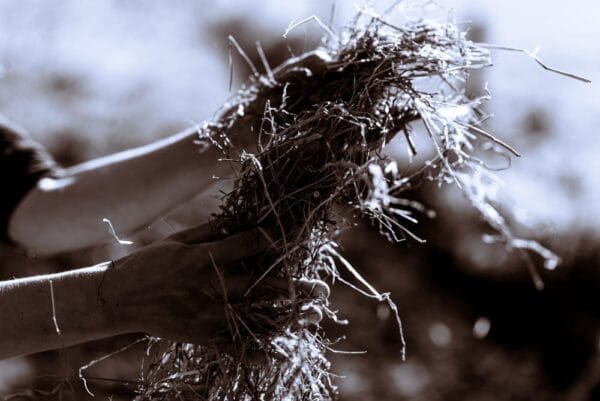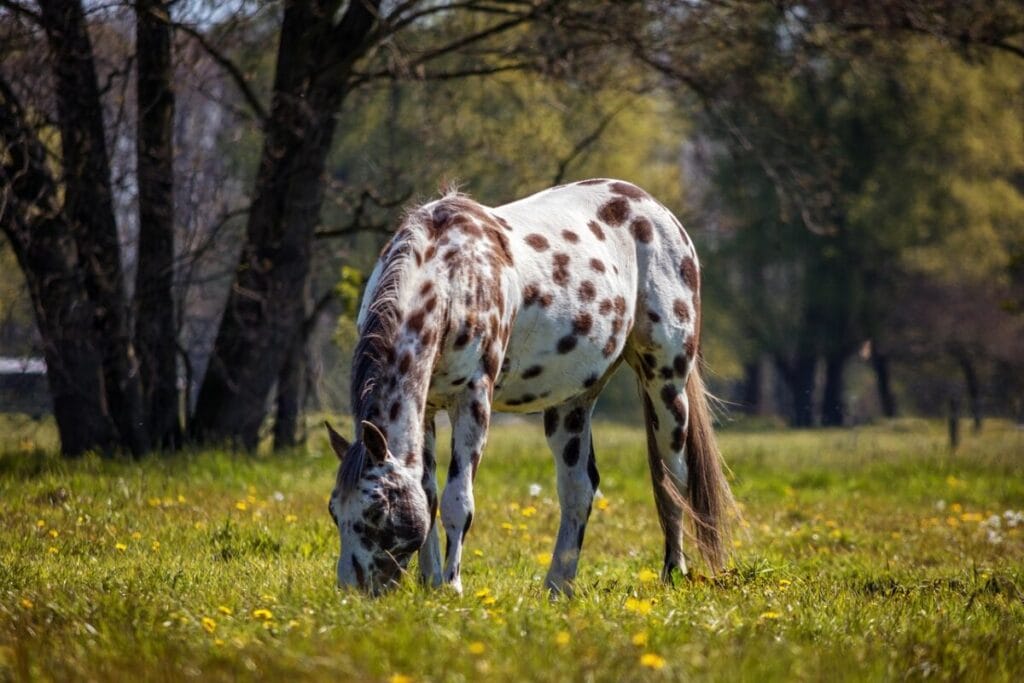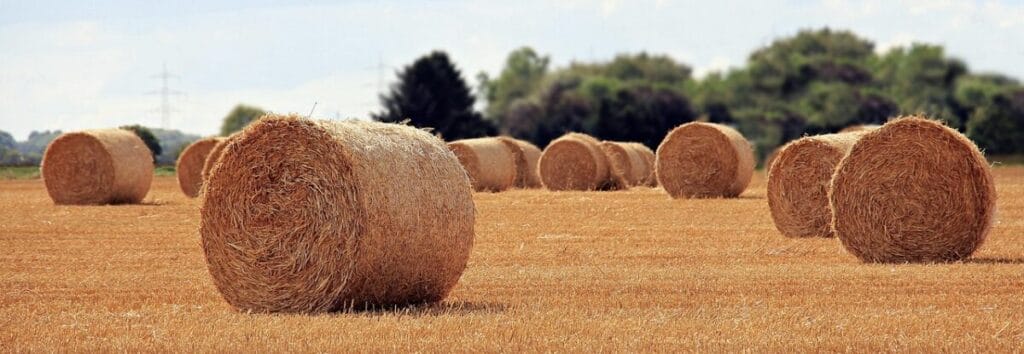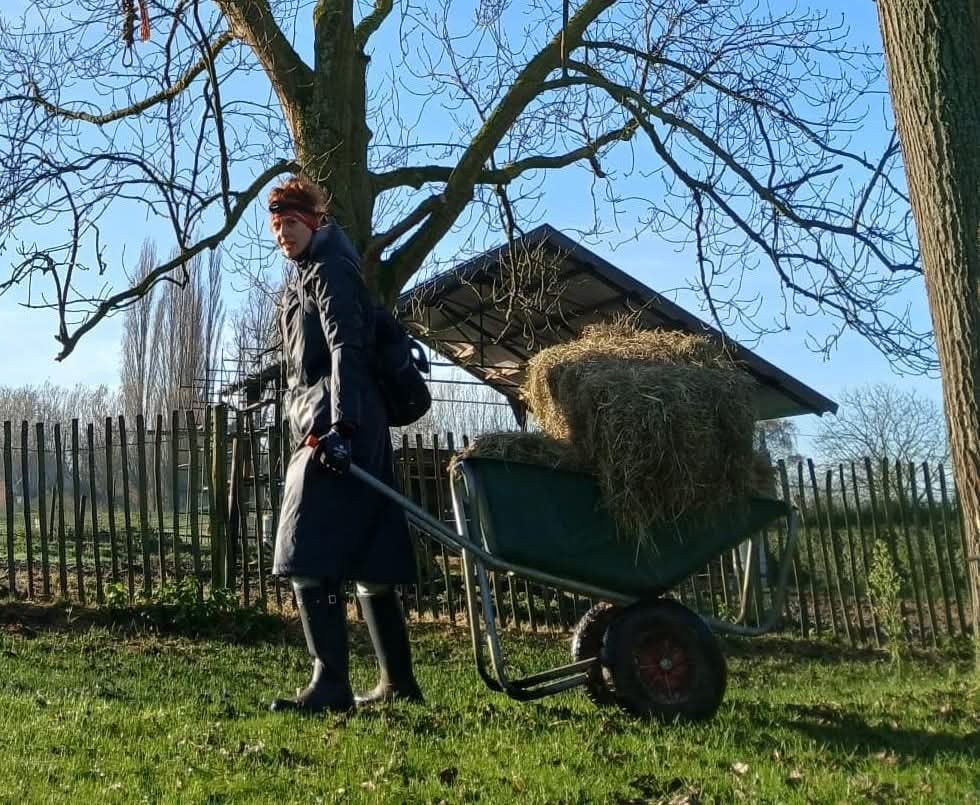Roughage
Roughage
Roughage forms the basis of every horse’s diet. It is essential for good digestion, dental health, well-being, and overall health of the animal. In this article, I summarize: the different types of roughage suitable for horses, with their characteristics, benefits, and points of attention.
Author: Katrien on 10/31/25
1. Hay
Hay is the most commonly used roughage for horses. It consists of dried grass or a mixture of different grasses. Hay is easy to store and portion. Its nutritional value depends on the time of mowing, the type of grass, and the drying method. There are two main types:
- Early hay: Harvested early in the season, contains more energy and protein, but is softer and more prone to dust.
- Late hay: Mowed later, coarser in texture, contains more fiber but less energy.
It’s important to pay attention to quality: mold-free, low-dust, and pleasantly smelling hay is ideal for horses.

2. Silage (haylage)
Silage, also known as haylage, is semi-dried grass that is packed airtight (usually in plastic bales) and ferments. It is moister than hay and therefore contains more lactic acid bacteria. Haylage is popular in wet climates where hay is difficult to produce. Note: silage for horses must be drier and mold-free compared to that for cattle.
Benefits of silage for horses:
- Dust-free, making it suitable for horses with respiratory issues.
- Higher moisture content than hay, contributing to better hydration.
- Often contains more nutrients than traditional hay, depending on the cut and harvest time.
- Easy to store and less prone to mold if packed correctly.
Disadvantages of silage for horses:
Risk of spoilage if not packed airtight, which can lead to mold growth or botulism.
May be too rich in energy and protein for easy keepers or horses with low energy needs.
Contains less fiber than hay, which can increase the risk of digestive issues.
The impact of silage on the gut flora in horses is an important consideration in ration management. Due to the higher moisture content and specific fermentation products in silage, changes can occur in the composition of the gut microbiota. This can be beneficial for some horses, but in sensitive animals, a sudden transition to silage can lead to disturbances, such as loose stools or colic. Therefore, it is advisable to gradually adjust the ration when switching from hay to silage, allowing the gut flora to adapt smoothly to the new feed.
Not all horses enjoy silage equally due to its taste and smell. For more information and scientific support on feeding silage to horses, see among others: Müller, C.E., & Udén, P. (2007). “Preference of horses for grass silages and haylage with different botanical composition, dry-matter content and fermentation characteristics.” Animal Feed Science and Technology
3. Grass
Fresh grass is the most natural roughage for horses and contains a lot of water, vitamins, and minerals. Grazing provides exercise and continuous food intake. Be cautious with lush spring pastures: too much young grass can cause laminitis or diarrhea. Limit grazing for sensitive horses and always build it up slowly.
A track system, where horses are kept in a designated path or ‘track’ around a pasture or terrain, can be particularly valuable for their well-being. The track system promotes natural movement as horses are encouraged to cover longer distances in search of food, water, and resting places. This not only helps prevent boredom but also supports healthy digestion, the musculoskeletal system, and condition. Additionally, it ensures that horses eat less grass at once, reducing the risk of obesity, colic, and metabolic issues such as laminitis. This setup aligns well with the natural behavior and needs of the horse, ultimately contributing to their overall health and well-being.

4. Alfalfa
Alfalfa is a leguminous plant rich in proteins, calcium, and fibers. It is often given as a supplement, in the form of pellets, chopped, or mixed in with hay. Alfalfa supports muscle development, but too much can lead to kidney problems in some horses due to its high protein and calcium content. So, feed it in moderation.
Chewing on alfalfa offers several health benefits for horses. The coarse structure of alfalfa requires intensive chewing, which stimulates saliva production and helps maintain a stable acid level in the stomach. This helps prevent stomach issues, such as gastric ulcers. Additionally, alfalfa naturally contains high levels of fiber, protein, and calcium, making it an excellent supplement for horses that need extra nutrients, such as sport horses or young growing animals. The slow absorption reduces the risk of bolting food and helps maintain optimal digestive function. Finally, alfalfa contributes to a feeling of satiety and helps prevent obesity, especially when used as part of a well-balanced diet.

5. Straw
Straw is usually used as bedding, but it can also serve as roughage, especially for horses that gain weight easily. Wheat straw is the most suitable; oat straw is too coarse, and barley straw can contain dust. Straw has low nutritional value but is high in fiber, which stimulates digestion. Note: too much straw can cause blockages.

6. Haylage
Haylage is similar to silage but usually contains less moisture and is finer in texture. It is popular in England and Ireland. Haylage is tasty and dust-free but must be stored carefully to prevent spoilage.

7. Roughage substitutes
Pressed forage products: There are various pressed products such as forage pellets and grass pellets. These are convenient for horses with dental problems or older horses, as they can be soaked into an easily digestible mash. At Flo Féa, they call these: forage replacers.
Metazoa Naturalfit Haycobs (grasbrok) 15kg
Gezonde vezels en extra vochtopname: klaar in 1 minuut met koud water!
Trakteer je paard op een lekkere gezonde slobber boordevol vezels. Klaar binnen enkele minuten, ook met koud water. Brokken vallen heel snel uit elkaar wat géén risico geeft op slokdarmverstopping.
In stock (can be backordered)
How much Roughage Does a Horse Need?
The amount of roughage a horse needs daily depends on its body weight, activity level, and health condition. In general, it is recommended that an adult horse receives at least 1.5 to 2% of its body weight in dry matter from roughage per day. For a 500 kg horse, this means between 7.5 and 10 kg of dry matter per day. This not only helps to meet nutritional needs but also supports healthy bowel function and prevents boredom.
Dry Matter per Type of Roughage for Horses
The amount of dry matter in roughage varies greatly per type. Hay usually contains the highest percentage of dry matter, usually between 80% and 90%. This means that hay contains relatively little water and is therefore more durable. Silage, on the other hand, has a lower dry matter content, often between 40% and 70%, depending on the stage of ensiling and the technique used. Fresh grass has the lowest dry matter percentage, usually around 20% to 25%, which means that horses have to eat large quantities of it to meet their needs.
When composing the ration, it is important to take these differences into account. After all, dry matter is the nutrient-rich component of the roughage, while the water content mainly affects the volume and shelf life. By properly matching the dry matter content to the energy needs and the type of horse, you contribute to healthy nutrition and digestion.
- Hay: 80–90% dry matter
- Silage: 40–70% dry matter
- Fresh grass: 20–25% dry matter
Always check the dry matter content of your roughage, especially if you switch between different types or compose a ration for horses with specific needs, such as thrifty breeds or animals with low energy needs. This way you keep the ration optimally tailored to your horse.
A slowfeeder is a feeding solution for horses that offers roughage slowly and in a dosed manner. This system often consists of a sturdy net, container or rack with small openings, which forces the horse to ingest the feed in smaller portions. This prevents gulping, the horse eats its portion for longer and boredom is counteracted. In addition, a slow feeder stimulates natural eating behavior, supports healthy digestion and helps reduce the risk of obesity or metabolic problems. Slow feeders are particularly useful in ration management, especially for horses that are prone to eating too quickly or that are offered limited roughage.
Forage Analysis:
The Vitalbix Roughage Quick Scan is a practical tool that gives you insight into the nutritional value of the roughage you feed your horse or pony. The comprehensive analysis report contains exact values for energy, protein (showing not only EWpa but also VREp: the digestible crude protein), sugar, crude fiber, lignin, and dry matter. So you don’t get estimates, but concrete figures that allow you to specifically manage your animal’s diet.
Does your horse have trouble transitioning from one type of roughage to another? Read more here.
Roughage:
Log in and leave a comment (and earn 2 Flo Féa Points)
The comment form will be visible below once you’re logged into your account.
Welcome to Flo Féa
Digestive Imbalance
Digestive Imbalance Here’s how to Naturally Support your Horse’s Digestion and Immunity: The transition from…
Roughage
Roughage Roughage Roughage forms the basis of every horse’s diet. It is essential for good…
BF Petfood
Flo Féa houdt van jouw hond! Discover the range of BF PetfoodONTDEK
Laminitis in horses: Causes, symptoms and scientific insights
Laminitis in horses: Causes, symptoms and scientific insightsCauses, symptoms and scientific insightsLaminitis, also known as…
A Horse’s Natural Needs: How to Support Them for Optimal Well-Being
The natural needs of a horseHow to support them for optimal well-beingHorses are naturally social…
Feeding and caring for a horse in winter: Tips and scientific insights
Feeding and Caring for a Horse in Winter: Tips and Scientific InsightsTips and scientific insights…





